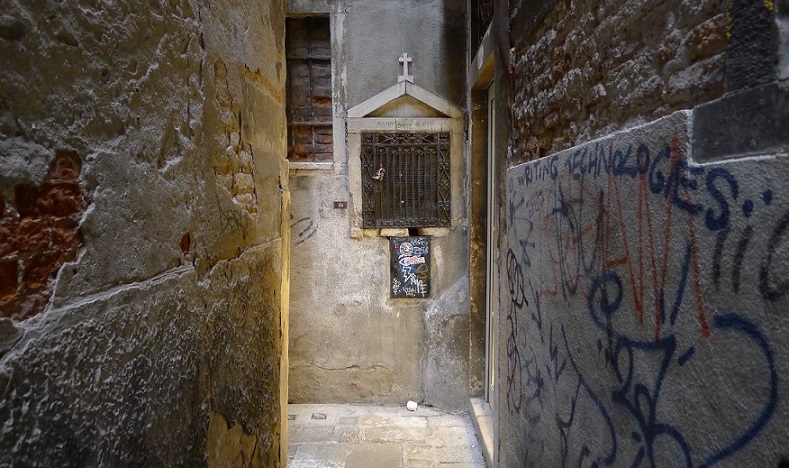藝術議題
- 威尼斯雙年展最新的專題文章如下。如欲閱讀有關同一議題的其他文章,可再點擊右下角資料庫的年份和月份。
魅力不凡的威尼斯 | Magical Venice
約翰百德 (John BATTEN)
at 8:37pm on 21st June 2019

圖片說明:
轉過小巷角落,聖母正在保佑這個城市的平安。照片由作者提供
Caption:
Turn an alley corner, and there is the Madonna giving hopeful protection. Photo: John Batten
(Please scroll down for English version)
威尼斯的大運河沒有我想像中的闊和長,但大運河兩岸的宮殿、又高又瘦的多層房屋、小巷、門廊、運河、廣場,還有教堂林立及被海包圍的城市,以及段段軍事佔據的驚險歷史,還有財富、藝術、虔誠、人們對放縱生活和經商的野心,可說魅力不凡。這是我首次踏足威尼斯,也是第一次到訪意大利。這次意國之旅是專程參觀威尼斯藝術雙年展,支持香港的參加者,包括藝術家謝淑妮和策展人李綺敏。謝氏的展覽是深思熟慮、穿梭整個展場的雕塑裝置,各個部件緊扣相連,彷如威尼斯縱橫交錯的大街小巷與運河。我將會在未來的文章中再詳述謝氏的展覽。
我應該早於30年前首次歐遊時便探訪意大利,但那時世界動盪不安,美國正在報復伊拉克入侵科威特,第一次波斯灣戰役展開。我幾乎跟著戰爭走:在巴黎,我透過短波收音機聽到入侵的決定就在當天於巴黎作出。我和兩位香港朋友那天早上在位於法國軍事總部旁的羅丹美術館散步。憲兵就在街角,他們身上都配備機關槍。街道上沒有車輛停泊,空氣中濔漫著隱藏炸彈隨時爆炸的恐懼。接下來數星期,我們到過法國、西班牙與摩洛哥,在咖啡室的電視與人們對話之間窺見了戰爭進程。收音機的報導把戰爭聲音放大:飛毛腿導彈、空襲、軍隊動向,還有在被伊拉克佔領的科威特,平民被扣押與謀殺的故事。
我們最後乘船來到摩洛哥, 坦吉爾的海傍帶著不老實的氣氛,這裡聚集了不少以兜攬遊客生意維生的人,他們的收入隨著旅客不再到歐洲旅遊而銳減。他們當中有些對戰爭感到憤怒,向我們叫囂道:「猶太人愛好者 ,美國混蛋!」(我們兩者都不是),其他則跟蹤我們徒步往山上找酒店。緊張的氣氛隨著我們到達菲斯這個同樣充滿魅力的古城市而放緩。過去數百年來,菲斯的大學與文化都為伊斯蘭教提供養份。它在伊斯蘭世界的重要性與悠久的宗教歷史,就如基督教的威尼斯。數星期前一次炸彈襲擊摧毀了一間酒店,不少遊客身亡,而通常積極招攬遊客生意,帶著他們漫遊古城迷宮般街道的嚮導,也與外國人保持距離,生怕被別人看到「與敵為友」。當時其實也沒有多少外國人,他們都在避免周遊列國和可能出現的劫機事件。
在我們走過摩洛哥南部,然後再往北回到巴塞隆納之時,戰爭結束了,未如人意的「勝利」引發了怨恨與不滿,造成了數年後紐約世貿中心的恐襲事件。這是阿富汗、伊斯蘭國崛起、敘利亞內戰、利比亞卡達菲被推翻,還有中東各地出現人民力量抗議等連串亂子的開始。歷史發至今也沒有多大改變,類似的控制、權力、貿易與宗教信仰鬥爭,早就在文藝復興時代,十字軍的聖地之戰時在威尼斯出現過。
我決定前往倫敦工作,說服自己歷史源遠流長的意大利與威尼斯可以留待下次再去––即使我們都已擁有全球暖化的環境意識,知道潮水一直高漲,它一直都會在。但是,如果我早知道威尼斯如此充滿魅力、這樣獨一無二,我可能三十年前便要更決心要到訪當地。
菲斯與威尼斯有著相同的城市規劃優勢:車輛無法穿梭兩者狹隘的街道。在威尼斯,貨物都以小船運輸,而菲斯至今仍然採用驢子,還有徒步行走。正因如此,即使威尼斯滿佈像我一樣的旅客,在街道之間遊走仍然是賞心樂事。威尼斯當地居民的日常節奏繼續進行:市場有其顧客、教堂有其信眾、學校有其學生、當地的酒吧或咖啡室繼續讓當地人站在櫃枱前喝過特濃咖啡便離去,這和市內眾多服務旅客的食肆截然不同。我聽說獨特的威尼斯方言仍然有人說,而且深得年輕人欣賞。城內的民生商店可以在較小的後巷找到,包括理髮店、寵物用品店、超市、影印店、電器師傅、郵局和空調修理店等。抬頭看,是居民晾曬的衣物,還有十字架與聖人在收音機緊張的足球賽評述聲中,俯視威尼斯的大小廣場。轉過小巷角落,聖母正在保佑這個城市的平安;而當地的酒館正在發售該區出產的佳釀,它們按壺出售,由酒桶倒進廉價的塑膠瓶內!
魅力威尼斯:經歷戰火、宗教爭端,仍然屹立不倒。
原文刊於《明報周刊》,2019年5月25日
Magical Venice
by John Batten
Venice’s Grand Canal is not as wide or as long as I had imagined, but on either side of it, the palaces, gangling storied houses, alleys, and corridors, canals, piazzas, and a city that wraps itself around its churches, the sea and a history of danger, military conquests, riches, art, piety, decadence and mercantile ambition is magical. It is my first time in Venice, indeed my first trip to Italy. I am here to ‘see’ the Venice Biennale of art and be supportive of Hong Kong participant, artist Shirley Tse and curator Christina Li. Tse’s exhibition is a considered, rambling sculptural installation of connections and intersections that coincidentally mirrors the streets and canals of Venice itself. I will write of Tse’s exhibition in a future column.
I should have visited Italy thirty years ago on my first trip to Europe, but the world was in turmoil then – again - as the USA retaliated to Iraq’s invasion of Kuwait and the first Gulf War began. I almost tracked the war: in Paris, I heard on my short-wave radio that a decision to invade would be made that day in Paris. I and two Hong Kong friends walked that morning near the Rodin Museum adjacent to France’s military headquarters. Gendarmes were on street corners, machine-guns at their hips. The streets were cleared of parked cars. Fear of planted bombs was in the air. Over the following weeks through France, Spain and Morocco, we glimpsed the war’s progress on café TVs and snatches of conversations. Radio reports amplified the sounds of war: Scud missiles, aerial attacks, troop movements, stories of civilian detention and murder in Iraq-occupied Kuwait.
Eventually arriving in Morocco by boat, on Tangier’s dodgy waterfront were desperate touts whose income had plummeted as tourists stopped travelling around Europe. Angry about the war, some screamed at us, “Jew lovers and American assholes!” (we were neither), others stalked us as we walked uphill in search of a hotel. Tensions eased as we arrived in that other magical, ancient city: Fes; whose universities and culture have fed Islam for centuries. Its importance and depth of religious history is for the Islamic world as Venice is for the Christian. Weeks earlier, a fire-bomb had destroyed a hotel, tourists died and the usually aggressive touts who work as guides leading visitors through the old city’s labyrinthine streets stayed away from foreigners, fearful of being seen to be friendly with ‘the enemy’. There were few foreigners anyway, who were avoiding international travel and possible air high-jackings.
Travelling through Morocco’s south and then back north to Barcelona, the war ended as an unsatisfactory ‘victory’ resulting in resentment and dissatisfaction that would be played-out again only a few years later after the World Trade Center attacks in New York. It was the beginning of the mess in Afghanistan, the rise of Isis, Syrian civil war, the fall of Gaddafi in Libya and people power protests throughout the Middle East. Nothing’s much changed: it is a similar history of control, power, trade and religious conviction as seen in Renaissance Venice while the Crusades were fought in the Holy Land.
I decided to go to London to work, convincing myself that historic Italy and Venice could await another time. It would always be there - high tides, and our newer environmental awareness of global warming, permitting. But, had I known Venice was so magical, so unique, I might have been more determined to visit thirty years earlier.
Both Fes and Venice share a marvelous town planning advantage: no cars or vehicular traffic can navigate their narrow streets. In Venice, transportation of goods is by boat, in Fes it is (still) by donkey – and, of course, walking. This makes Venice a pleasure despite the throngs of tourists, like me, traipsing the streets. Venice’s daily local-residential rhythms continue: markets have buyers, churches have worshippers, schools have students, a local bar or café is where locals order an espresso, gulp it down while standing at the counter, and leave - so different from the city’s many tourist restaurants. I am told the distinctive Venetian dialect is still spoken and used and appreciated by young people. The city’s essential businesses can be found in smaller back alleys: hairdressers, pet supply shops, supermarkets, photocopy places, electricians, post offices and air-conditioning repair shops. Above, is drying washing and crucifixes and saints overlooking the city’s piazzas amidst the excited sounds of a football match radio commentary. Turn an alley corner, and there is the Madonna giving hopeful protection; and, the local wine shop sells the region’s wine by the flagon dispensed from a barrel into cheap plastic bottles!
Magical Venice: through wars, religious conflict and disputes it is still here.
Originally published in Ming Pao Weekly, 25 May 2019. Translated from the original English by Aulina Chan.
